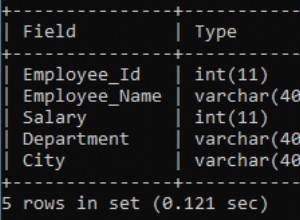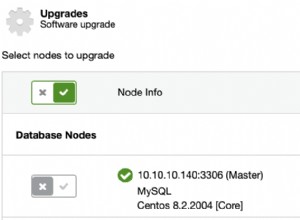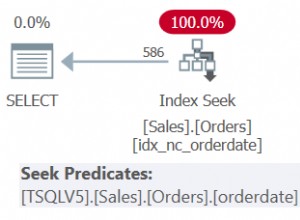Problem z twoją próbą polega na filtrowaniu na początku. Jeśli mam rację, chcesz pogrupować swoje dane (pogrupować je wszystkie) według ich relacji, wstępujących lub potomnych, lub ich mieszanką. Na przykład ID 100 ma dziecko 101 , który ma inne dziecko 102 , ale 102 ma rodzica 103 i chcesz, aby wynik był tymi czterema (100, 101, 102, 103 ) dla każdego wejścia znajdującego się w tym zestawie. Dlatego nie możesz filtrować na początku, ponieważ nie masz żadnych środków, aby dowiedzieć się, który związek będzie powiązany z inną relacją.
Rozwiązanie tego nie jest tak proste, jak się wydaje i nie będziesz w stanie go rozwiązać za pomocą tylko jednej rekurencji.
Oto rozwiązanie, które zrobiłem dawno temu, aby pogrupować wszystkie te relacje. Pamiętaj, że w przypadku dużych zbiorów danych (powyżej 100 000) obliczenia mogą zająć trochę czasu, ponieważ najpierw trzeba zidentyfikować wszystkie grupy, a na końcu wybrać wynik.
CREATE PROCEDURE GetAncestors(@thingID INT)
AS
BEGIN
SET NOCOUNT ON
-- Load your data
IF OBJECT_ID('tempdb..#TreeRelationship') IS NOT NULL
DROP TABLE #TreeRelationship
CREATE TABLE #TreeRelationship (
RelationID INT IDENTITY(1,1) PRIMARY KEY NONCLUSTERED,
Parent INT,
Child INT,
GroupID INT)
INSERT INTO #TreeRelationship (
Parent,
Child)
SELECT
Parent = D.Parent,
Child = D.Child
FROM
Example AS D
UNION -- Data has to be loaded in both ways (direct and reverse) for algorithm to work correctly
SELECT
Parent = D.Child,
Child = D.Parent
FROM
Example AS D
-- Start algorithm
IF OBJECT_ID('tempdb..#FirstWork') IS NOT NULL
DROP TABLE #FirstWork
CREATE TABLE #FirstWork (
Parent INT,
Child INT,
ComponentID INT)
CREATE CLUSTERED INDEX CI_FirstWork ON #FirstWork (Parent, Child)
INSERT INTO #FirstWork (
Parent,
Child,
ComponentID)
SELECT DISTINCT
Parent = T.Parent,
Child = T.Child,
ComponentID = ROW_NUMBER() OVER (ORDER BY T.Parent, T.Child)
FROM
#TreeRelationship AS T
IF OBJECT_ID('tempdb..#SecondWork') IS NOT NULL
DROP TABLE #SecondWork
CREATE TABLE #SecondWork (
Component1 INT,
Component2 INT)
CREATE CLUSTERED INDEX CI_SecondWork ON #SecondWork (Component1)
DECLARE @v_CurrentDepthLevel INT = 0
WHILE @v_CurrentDepthLevel < 100 -- Relationships depth level can be controlled with this value
BEGIN
SET @v_CurrentDepthLevel = @v_CurrentDepthLevel + 1
TRUNCATE TABLE #SecondWork
INSERT INTO #SecondWork (
Component1,
Component2)
SELECT DISTINCT
Component1 = t1.ComponentID,
Component2 = t2.ComponentID
FROM
#FirstWork t1
INNER JOIN #FirstWork t2 on
t1.child = t2.parent OR
t1.parent = t2.parent
WHERE
t1.ComponentID <> t2.ComponentID
IF (SELECT COUNT(*) FROM #SecondWork) = 0
BREAK
UPDATE #FirstWork SET
ComponentID = CASE WHEN items.ComponentID < target THEN items.ComponentID ELSE target END
FROM
#FirstWork items
INNER JOIN (
SELECT
Source = Component1,
Target = MIN(Component2)
FROM
#SecondWork
GROUP BY
Component1
) new_components on new_components.source = ComponentID
UPDATE #FirstWork SET
ComponentID = target
FROM #FirstWork items
INNER JOIN(
SELECT
source = component1,
target = MIN(component2)
FROM
#SecondWork
GROUP BY
component1
) new_components ON new_components.source = ComponentID
END
;WITH Groupings AS
(
SELECT
parent,
child,
group_id = DENSE_RANK() OVER (ORDER BY ComponentID DESC)
FROM
#FirstWork
)
UPDATE FG SET
GroupID = IT.group_id
FROM
#TreeRelationship FG
INNER JOIN Groupings IT ON
IT.parent = FG.parent AND
IT.child = FG.child
-- Select the proper result
;WITH IdentifiedGroup AS
(
SELECT TOP 1
T.GroupID
FROM
#TreeRelationship AS T
WHERE
T.Parent = @thingID
)
SELECT DISTINCT
Result = T.Parent
FROM
#TreeRelationship AS T
INNER JOIN IdentifiedGroup AS I ON T.GroupID = I.GroupID
END
Zobaczysz to dla @thingID o wartości 100 , 101 , 102 i 103 wynikiem są te cztery, a dla wartości 200 , 201 i 202 wyniki to te trzy.
Jestem prawie pewien, że nie jest to optymalne rozwiązanie, ale daje prawidłowe wyniki i nigdy nie musiałem go dostrajać, ponieważ działa szybko zgodnie z moimi wymaganiami.




